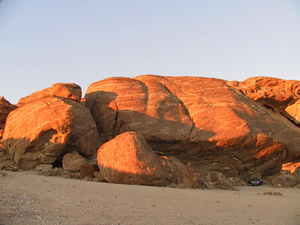Henk Dop: Namibia Trip Report 2005
Mirabib, Bloedkoppie, Swakopmund
Wednesday 27 April: Mirabib - Bloedkoppie; 246 km
After touring around Mirabib for a bit, we set out around 0800. We head back to Beacon Hill, seeing Springbok, Oryx and Ostrich on the way, as well as a Ludwig's Bustard. Zebra Pan is empty, it looks like this isn't the time that animals come to drink here from the water provided by a windmill. We continue West towards Homed, passing the abandoned workings of Gorob Mine and Hope Mine, and seeing Zebra in the distance before all vegetation disappears again. In the distance we can clearly see the course of the Kuiseb River, marked by the orange Namib dunes on its Southern bank: the periodic flow of the Kuiseb effectively stops any further Northern advance of these sands. To get to Homeb, we descend through a barren moonscape into the valley of the Kuiseb, where a small community of goat herders ekes out a living. We stop for coffee in the shade of a large Acacia on the sandy and exposed Homeb campsite, and I try to get to the other side of the riverbed through the dense riverine forest. However, the Acacia stands are too thick, it's suffocatingly hot and windless, so I retrace my steps.
We continue on the road to Gobabeb, the Namibian desert ecology research institute. Amazingly, we see some more Zebra in the almost featureless light grey stony plain, then turn right towards the East to get to Mirabib from the other direction. After passing the Inselberg we stop for a shot of a lonely Sprokiesboom ('fairy tree'- Moringa ovalifolia), already noted this morning and looking quite out of place: this tree shouldn't be here in this extremely dry area, or would the minute streambed it's standing in provide just enough water every now and then? It’s back to the C14, with some more Springbok near the base of Beacon Hill, we cross the road, and head for Ganab where we had planned to camp. On our way there, a large group of Ostriches flee from our sight on the base of Amichab mountain.
We inspect the Ganab campsite on the track to Gemsbokwater, and find it awfully exposed, and quickly decide to camp at Bloedkoppie (known from 2000), further North. We continue on the track to Gemsbokwater, and although usually marked as a 4WD track, it's actually quite good. Arriving there towards 1530, we have some difficulty in picking a campsite, as we have all of them to choose from. We finally opt for the most Western site, spacious and shady. After setting up camp, there's time to examine the season's remaining flowers, the ‘tok-tokkie’ Tenebrionid beetles running around, and a colourful Agame. Towards 1700, Marike and I take the car back into the plains for sunset shots among the Kokerbome, after which there's another fine boerewors braai. The evening ends with an unsolved mystery: was that near-continuous clicking made by tree-frogs or birds?
Thursday 28 April: Bloedkoppie - Swakopmund; 238 km
Maarten's profound dislike for insects in general, and flies in particular (admittedly, these were fairly abundant at Bloedkoppie), makes us decide to head for Swakopmund today instead of camping another night at Bloedkoppie. However, we will do another excursion first before coming back and breaking up camp. Our early start is rewarded by Springbok on the Bloedkoppie plains, but on our way to Ganab by way of the Hotsas waterhole we see nothing there, nor anything excepts a distant Oryx from the Voëlstruis (Ostrich) viewpoint. Closer to Ganab, there's a group of some 10 Oryx, and then suddenly a family of Meerkats cross the road and vanishes again into the grass. At least a few dozen Zebra can be seen around the base of the Tumasberg, but they're extremely skittish and run away at the first sight of us.
We turn left at Ganab to have another look at the Gemsbokwater track, and as we do so get a great close-up of a seemingly unconcerned Rüppel's Korhaan. Around 0945 we reach the area of yesterday's Springbok, only today they're not in their hundreds, it's more like thousands. Wall-to-wall Springbok, an amazing sight. I'm reminded of Henno Martin's closing paragraphs, in which he bemoans that probably, nobody will ever again see vast herds of Springbok in the desert as he used to do when he and his friend stayed in these parts. Well, this must come pretty close to that very same experience.
I try to approach the Springboks as slowly and carefully as I can, but we still cause quite a stampede. However, it’s brief and the vast herd settles down again. Springbok as far as the eye can see, and every time we point our binoculars at the next rolling grassy hill, and then the next again, we only see yet more and more of them. And the Ludwig's Bustard are also around: two pairs this time – clearly, this is a morning of superlatives.
However, it's not over yet, for along the fence that separates the Park from an Ostrich farm, a Giraffe has obviously just stepped across it, probably on its way to have a drink at Gemsbokwater. It's young is still on the other side of the fence, and clearly undecided on whether or not to also cross in our presence. We pass with great care so as not to create any fright that might cause either Giraffe to hurt itself on the wire - a process complicated by the fact that this is just where the track has some patches of nasty sand. Still, all goes well, and we run into our next surprise: a family of Warthogs. To my knowledge, it really is rare to see either Giraffe or Warthog this far out into the Namib.
At 1130 we have coffee at Bloedkoppie and break up camp, half an hour later I take the 4WD track from Bloedkoppie back to the C28. Again, a fine track, groups of Ostrich run away, and then suddenly we enter the 'dead-zone' again, which continues until we get to the furthest inland reaches of the coastal fog. And, just as we see this fog appearing in the distance, the first Welwsitschia's start to appear in dry watercourses. It now starts to get decidedly chilly, and we enter the outskirts of a foggy Swakopmond, turning right on the B2 towards Sofia Dale restcamp.
Sofia Dale restcamp (www.sophiadale.com/english/en.htm) was started some eight years ago by an immigrant family from former East Germany who were fed up with being treated as second-rate citizens after 'die Wende'. We had met with cheerful Didi May in 2000, only to learn a few months later of his untimely death in a stupid car accident (burst front tyre and overturned – there was a strong hint that he was speeding). We also stopped here last year, and then met with Henrik, one of two sons now helping their mother to continue the business. I'm met by a lady as I enter the reception, 'Frau May?'
She's surprised, yes, she's Bettina May, and I quickly explain - we had only seen her very briefly in 2000, she clearly has mixed feeling about this evocation of inevitably sad memories. Then Henrik steps into the reception, clearly recognising us with an 'I see you have the same car'. Because of the fog, which turns into a cold, fine rain in the night, we decide on one of the camp's rondavels, a neat two-bedroom thing at an acceptable price.
After freshing up we head into town for some shopping, due to works on the railway overpass there's a detour through Swakopmund's poorer quarter, a squalid shantytown that contrasts starkly with the quaint German splendour (if it may be called that) of downtown Swakop (see: www.namibweb.com/swakopmund.htm). Marike and Maarten raid the Shoprite, Maarten and I the local Windhoek supply. I visit the office of the Palmwag lodge and say 'Hi' to Chantell, I had had pleasant email exchanges with her for our prior and this year's booking, and had told her that I'd be dropping by. She seems more than surprised to actually see me do so, and we chat briefly and amicably. Back at Sofia Dale we re-arrange the car, now fully supplied and ready for the Skeleton Coast and the Kaokoveld.


